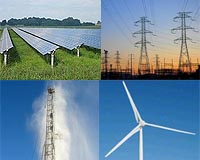 |
Mountain View CA (SPX) Jul 08, 2010 Prospects for the hydro, wave, and tidal power market look upbeat as countries are investing in renewable energy sources to augment energy security. It is estimated that the worldwide wave resources is 6,000 TWh/year, twice as much as global nuclear production and 700 TWh/year for tidal power. In other words, the market potential for the wave industry is about $1 trillion worldwide.
New analysis from Frost and Sullivan "It is projected that commercialization of wave and tidal energy will take place in the next 5-10 years as the technology evolves and production costs decline," notes Technical Insights Research Associate Chin Wai Loon. "Wave and tidal energy are expected to be deployed on a commercial scale due to its large promising resource and high market potential; it is crucial for technology developers to push through into the commercialization phase." The future of wave and tidal energy depends heavily on financial funding from public, private, and government entities. Deployment of wave and tidal technology will not be easily achievable due to large initial installation cost. The United Kingdom has provided 8 million pounds Sterling for the European Marine Energy Research Centre (EMEC). This research centre will serve as a testing facility for technology developers to create their devices. In another example, the UK Government has set up 22 million pounds Sterling funding to offset the large capital cost during the installation stage. Marine Current Turbines is another instance, raising sufficient funding to commercialize its 5-MW SeaGen technology. According to Alvin Smith, CEO of Dartmouth Wave Energy Ltd, the current cost for wave energy is estimated to be 2 million pounds Sterling per MW. Apart from this, the policies and regulations set by the government and the lack of awareness on the potential of wave and tidal resources are stalling market momentum. The extremely harsh weather conditions of the ocean require the technology to be very robust. Pelamis Wave Power has halted its 2.5 MW wave farm in Portugal indefinitely. The reason cited for this is water leakage, which has severely affected their buoyancy device. Apart from this, the company is short on funds due to the recent economic recession. "To ensure productive outcomes in this space, participants must accelerate their R and D efforts, conduct more sea trials, and reduce overall material usage," says Chin. "Participants must secure more funding from public, private and government sectors by developing prototypes for demonstrations or trial purposes." By securing ample financial assistance, large-scale devices can be developed to generate more electricity (MW range) instead of prototype scale (kW range). Case in point, Pelamis Wave Power has managed to secure 4.8 million pounds Sterling funding from the UK Government's Marine Renewable Proving Fund (MRPF). Technology developers could collaborate with each other to accelerate the commercialization phase, while reducing the overall cost. Joint ventures between companies and governments will serve to boost future development in marine renewable energies. Seabased AB, one of the key participants in the wave industry, has collaborated with Fortum Kellaniem to develop the largest wave farm in Sweden, capable of generating 10 MW capacity. Collaborations will not only ratchet down costs, but also help to compete with other renewable technologies, such as solar, hydro, and wind. Hydro, Wave, and Tidal Power--Market Penetration and Roadmapping, a part of the Technical Insights subscription, provides an in-depth analysis of market drivers and restraints, industry structure, and competitive environment besides dealing with the challenges and issues faced by market participants. Further, this research service includes detailed technology analysis and industry trends evaluated following extensive interviews with market participants. Technical Insights is an international technology analysis business that produces a variety of technical news alerts, newsletters, and research services.
Share This Article With Planet Earth
Related Links Frost and Sullivan
 Renewable Capacity Soars Across EU
Renewable Capacity Soars Across EUBrussels, Belgium (SPX) Jul 07, 2010 In 2009, and in absolute terms, about 19.9% (608 TWh) of Europe's total electricity consumption (3042 TWh) came from renewable energy sources. Hydro power contributed with the largest share (11.6%), followed by wind (4.2%), biomass (3.5%), and solar (0.4%). With regards to the new capacity constructed that same year (27.5 GW), among the renewable sources, 37.1% was wind power, 21% photovol ... read more |
|
| The content herein, unless otherwise known to be public domain, are Copyright 1995-2010 - SpaceDaily. AFP and UPI Wire Stories are copyright Agence France-Presse and United Press International. ESA Portal Reports are copyright European Space Agency. All NASA sourced material is public domain. Additional copyrights may apply in whole or part to other bona fide parties. Advertising does not imply endorsement,agreement or approval of any opinions, statements or information provided by SpaceDaily on any Web page published or hosted by SpaceDaily. Privacy Statement |